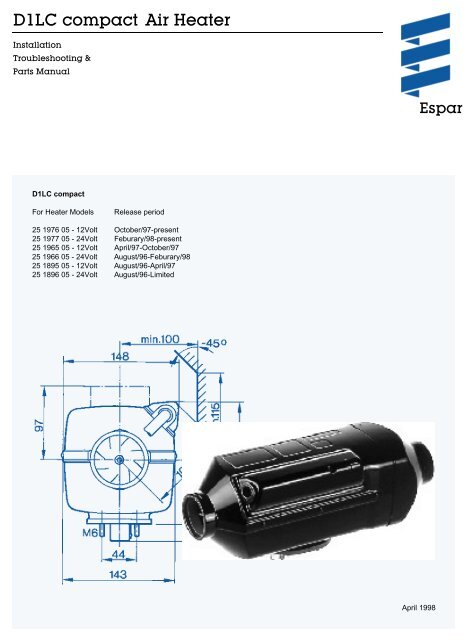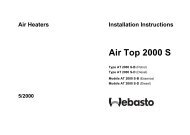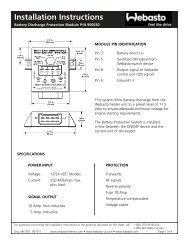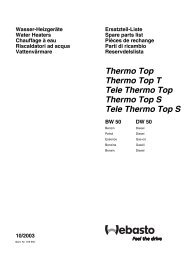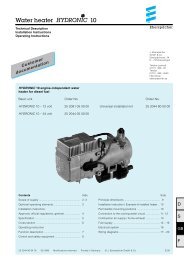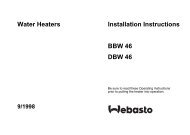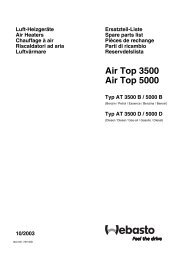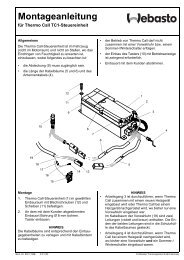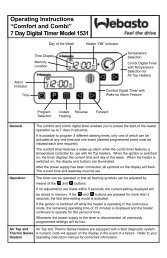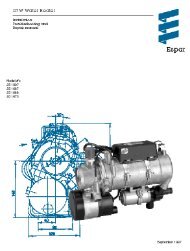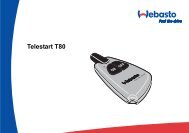D1LC compact Air Heater - Espar
D1LC compact Air Heater - Espar
D1LC compact Air Heater - Espar
Create successful ePaper yourself
Turn your PDF publications into a flip-book with our unique Google optimized e-Paper software.
<strong>D1LC</strong> <strong>compact</strong> <strong>Air</strong> <strong>Heater</strong><br />
Installation<br />
Troubleshooting &<br />
Parts Manual<br />
<strong>Espar</strong><br />
<strong>D1LC</strong> <strong>compact</strong><br />
For <strong>Heater</strong> Models<br />
Release period<br />
25 1976 05 - 12Volt October/97-present<br />
25 1977 05 - 24Volt Feburary/98-present<br />
25 1965 05 - 12Volt April/97-October/97<br />
25 1966 05 - 24Volt August/96-Feburary/98<br />
25 1895 05 - 12Volt August/96-April/97<br />
25 1896 05 - 24Volt August/96-Limited<br />
April 1998
Table of Contents<br />
Page<br />
Introduction <strong>Heater</strong> Warnings ........................................................ 2<br />
Introduction ........................................................ 3<br />
Specifications ........................................................ 4<br />
Principal Dimensions ........................................................ 5<br />
Mounting Pattern ........................................................ 5<br />
<strong>Heater</strong> Components ........................................................ 6<br />
Installation Procedures <strong>Heater</strong> Location ........................................................ 7<br />
<strong>Heater</strong> Mounting ........................................................ 7<br />
<strong>Heater</strong> <strong>Air</strong> Ducting ........................................................ 7<br />
<strong>Heater</strong> Plumbing ........................................................ 7<br />
Ducting Components ........................................................ 8<br />
Fuel System ........................................................ 8<br />
Electrical Connections ........................................................ 11<br />
Exhaust/Intake Connections ........................................................ 12<br />
Operating Switches ........................................................ 12<br />
<strong>Heater</strong> Operation Switch on ........................................................ 13<br />
Start-Up ........................................................ 13<br />
Temperature setting ........................................................ 13<br />
Temperature Control ........................................................ 13<br />
Switching Off ........................................................ 13<br />
Controls & Safety Equipment ........................................................ 13<br />
Operational Flow Chart ........................................................ 14<br />
Schematic 25 1976/1977 ........................................................ 15<br />
Schematic 25 1965/1966 ........................................................ 16<br />
Schematic 25 1895/1896 ........................................................ 17<br />
Maintenance, Periodic Maintenance ........................................................ 18<br />
Troubleshooting & Basic Troubleshooting ........................................................ 18<br />
Repairs Self Diagnostic Troubleshooting ....................................................... 19<br />
Fuel Quantity Test ........................................................ 22<br />
Component Spec chart ........................................................ 22<br />
Repair Steps ........................................................ 23<br />
<strong>Heater</strong> Parts <strong>D1LC</strong> Compact-Parts Diagram ........................................................ 26<br />
<strong>D1LC</strong> Compact-Parts List ........................................................ 29<br />
Special Notes<br />
Note: Highlight areas requiring special attention or clarification.<br />
Caution: Indicates that personal injury or damage to equipment may occur unless specific guidelines are followed.<br />
Warning: Indicates that serious or fatal injury may result if specific guidelines are not followed.
2<br />
<strong>Heater</strong> Warnings<br />
Warning To Installer:<br />
Correct installation of this heater is necessary to ensure<br />
safe and proper operation.<br />
Read and understand this manual before attempting to<br />
install a heater.<br />
Warning - Explosion Hazard<br />
1. <strong>Heater</strong> must be turned off while re-fueling.<br />
2. Do not install heater in enclosed areas where<br />
combustible fumes may be present.<br />
3. Do not install heaters in engine compartments of<br />
gasoline powered boats.<br />
Warning - Fire Hazard<br />
1. Install heater so it will maintain a minimum distance of<br />
2” from any flammable or heat sensitive material.<br />
2. Install the exhaust system so it will maintain a<br />
minimum distance of 2” from any flammable or heat<br />
sensitive material.<br />
3. Ensure that the fuel system is intact and there are no<br />
leaks.<br />
Failure to follow these instructions could cause fire resulting<br />
in serious or fatal injur y.<br />
Warning - Asphyxiation Hazard<br />
1. Route the heater exhaust so that exhaust fumes can<br />
not enter any passenger compartments.<br />
2. Ensure an air tight seal will be maintained between<br />
the heater and mounting surface and at any exhaust<br />
connection points.<br />
3. Ensure that heating air supply is taken from an area<br />
where poisonous gases will not be present.<br />
4. If running exhaust components through an enclosed<br />
compartment, ensure that it is vented to the outside.<br />
Failure to follow these instructions could cause oxygen<br />
depletion resulting in serious or fatal injury.<br />
Direct questions to <strong>Espar</strong> <strong>Heater</strong> Systems<br />
USA 1-800-387-4800<br />
CDA 1-800-668-5676
3<br />
Introduction<br />
<strong>Espar</strong> <strong>D1LC</strong> Compact <strong>Air</strong> <strong>Heater</strong><br />
The <strong>Espar</strong> <strong>D1LC</strong> <strong>compact</strong> is a diesel-fired 7,500 BTU/HR<br />
air heater, quality engineered to provide a dependable<br />
means of space heating.This heater is uniquely designed<br />
for inside mounting and ease of installation.<br />
The heater provides hot air to the interior of vehicles for<br />
passenger comfort. Since the heater runs on diesel fuel<br />
and 12 or 24 volt power, it is able to provide space heat<br />
completely independently of the vehicle engine.<br />
The heater is operated by a rheostat switch or<br />
room thermostat. It cycles through four temperature<br />
settings (boost-high-medium-low) in order to<br />
maintain the desired temperature.<br />
If, in special cases, less heating capacity is required than<br />
the heater supplies in the “Low” setting, the heater switches<br />
to the “Off” setting. Temperature and overheat limit<br />
switches, and a specially designed heat exchanger are<br />
among the safety features which make this heater a safe<br />
and dependable unit.
4<br />
Specifications<br />
Heat Output (±10%)<br />
Current at 12v (±10%)<br />
Current at 24v (±10%)<br />
7,500 BTU/hr Boost<br />
6,150 BTU/hr High<br />
4,100 BTU/hr Medium<br />
2,900 BTU/hr Low<br />
20.8 amps/hr - Start<br />
2.5 amps/hr - Boost<br />
1.8 amps/hr - High<br />
0.8 amps/hr - Medium<br />
0.8 amps/hr - Low<br />
11.25 amps/hr - Start<br />
1.25 amps/hr - Boost<br />
0.9 amps/hr - High<br />
0.4 amps/hr - Medium<br />
0.4 amps/hr - Low<br />
Fuel Consumption (±10%) U.S. Litre/hr<br />
Gal/hr<br />
Boost .07 .27<br />
High .06 .21<br />
Medium .04 .14<br />
Low .03 .10<br />
<strong>Air</strong> Flow (±10%)<br />
Operating Voltage Range<br />
Overheat Temperature<br />
Shutdown (±10%)<br />
Ambient Operating<br />
Temperature<br />
Weight<br />
50 cfm Boost<br />
43 cfm High<br />
30 cfm Medium<br />
30 cfm Low<br />
10.5 to 15.9 vdc at 12 vdc<br />
21.0 to 31.8 vdc at 24 vdc<br />
240°F (116°C)<br />
-40°F to 122°F (-40°C to 50°C)<br />
7.7 lbs. (3.5kg)<br />
Note: The heater control unit is equipped with a low<br />
voltage cutout to prevent vehicle battery drain and<br />
a high voltage cutout to protect heater electrical<br />
parts.
5<br />
Principal Dimensions<br />
* All measurements in inches<br />
1”= 2.5 cm<br />
Mounting Pattern<br />
If fastening to the vehicle wall/floor, make penetrations in<br />
accordance with the hole pattern shown below. A prepunched<br />
mounting kit is also available as shown beside.
6<br />
<strong>Heater</strong> Components<br />
1 Hot <strong>Air</strong> Blower Wheel<br />
2 Blower Motor<br />
3 Combustion <strong>Air</strong> Blower Wheel<br />
4 Glow Plug<br />
5 Control Unit<br />
6 Safety Thermal Sensor<br />
7 Combustion Chamber<br />
8 Flame Monitor<br />
9 Heat Exchanger<br />
10 Operating Unit (Thermostat)<br />
11 Operating Unit (Rheostat)<br />
12 Outer Casing<br />
13 Exhaust Line<br />
14 Flange Seal<br />
15 Fuel Line<br />
16 Main Fuse, 25 A<br />
17 Combustion <strong>Air</strong> Intake Line<br />
18 Fuel Metering Pump<br />
19 Fuel Strainer<br />
C = Combustion <strong>Air</strong><br />
D = Fuel<br />
E = Exhaust<br />
F = Fresh <strong>Air</strong><br />
H = Hot <strong>Air</strong>
7<br />
Installation Procedures<br />
<strong>Heater</strong> Location<br />
Depending on the type of vehicle, the best location for<br />
mounting the heater will vary. Typically, heaters are mounted<br />
inside tool or luggage compartments. However, the<br />
heater may be mounted anywhere inside the vehicle provided<br />
you adhere to the following conditions:<br />
Note: Tighten screws sufficiently to ensure positive seal<br />
between mounting plate and mounting surface.<br />
Do not over tighten.<br />
• Combustion air intake, exhaust and fuel inlet must be<br />
located outside of the vehicle.<br />
• <strong>Heater</strong> must be mounted on flat horizontal surface<br />
providing an air tight seal between heater and vehicle.<br />
• Do not mount the heater outside the vehicle, unless care<br />
is taken to protect the heater from the weather.<br />
When selecting the location, consider the following:<br />
• Combustion air and exhaust connections.<br />
• Ducting.<br />
• Fuel line connections.<br />
• Electrical connections.<br />
<strong>Heater</strong> Mounting<br />
A mounting plate and hardware are provided with the truck<br />
heater kit.<br />
• Choose heater location.<br />
• Using template provided, drill and cut center hole. Cut<br />
one (1) four and one half inch (4 1/2”) diameter hole or<br />
one rectangular hole four (4”) by five (5”) inches.<br />
• Mount heater on mounting plate with nuts and spring<br />
washers provided.<br />
• For ease of installation make the exhaust, combustion<br />
air intake and fuel connections at base of heater before<br />
mounting the heater into the vehicle.<br />
• Position heater in vehicle and secure with “Tek” screws<br />
provided.<br />
<strong>Heater</strong> <strong>Air</strong> Ducting<br />
Installation<br />
A 60mm flexible duct 40 inches long, hot air outlet and<br />
clamps are provided with the heater kit.<br />
• In routing and installing the ducting the following criteria<br />
must be observed:<br />
• Run ducting with smooth bends. Avoid crushing duct.<br />
• Position hot air outlet so that it cannot be obstructed.<br />
• Use protective air intake grille on air inlet side of heater<br />
to prevent objects from being sucked in.<br />
• Ensure provisions are made for proper air return<br />
ventilation.<br />
• Use return air ducting for best heating efficiency<br />
(see below).<br />
Return Ducting<br />
<strong>Heater</strong> Mounting Plate Installation<br />
Figure IIA<br />
HEX HEAD<br />
TEK SCREW<br />
FLAT WASHER<br />
SILICONE GASKET<br />
S.S. PLATE<br />
PLATE SEAL<br />
NUT<br />
SPRING WASHER<br />
CAB FLOOR
8<br />
Ducting Components<br />
1. Protective Grill 3. Hose Clamp 2-2 3/4” 5. <strong>Air</strong> Outlet - Rotatable 7. 90° Bend Ducting 2 3/8”<br />
2. <strong>Air</strong> Outlet Hood 4. Flex Duct 2 3/8” 6. Connection Piece<br />
Warning:<br />
Do not use existing vehicle ducting or outlets.<br />
Ducts and outlets must be capable of<br />
withstanding a minimum of 300°F operating<br />
temperatures. To avoid exhaust leakage,<br />
the heater must always be operated<br />
with an end cap installed.<br />
Caution:<br />
Do not over tighten duct clamps.<br />
Do not position outlet so that it will blow hot<br />
air directly at operator or at room thermostat.<br />
Fuel System<br />
The fuel metering pump is the heart of the system and<br />
must be installed properly to ensure a successful heater<br />
operation.<br />
Fuel System Overview<br />
7<br />
6<br />
Max. 6’6”<br />
Max. 20’<br />
6<br />
7<br />
8<br />
Max. 6’6”<br />
2<br />
3<br />
5<br />
Max. 2’6”<br />
Fuel<br />
Tank<br />
1<br />
2<br />
3<br />
Fuel<br />
Tank<br />
1<br />
4<br />
Max. 2’<br />
9<br />
3<br />
3<br />
5<br />
Optional<br />
Note: Butt joints and clamps on all connections.<br />
1. Fuel Pick-Up Pipe<br />
2. 5.0 Rubber Connector<br />
3. 11mm Clamp<br />
4. 2.0mm Black Plastic Fuel Line<br />
5. Fuel Metering Pump<br />
6. 9mm Clamp<br />
7. 3.5mm Rubber Connector<br />
8. 1.5mm White Plastic Fuel Line<br />
9. 5mm Rubber Fuel Line
9<br />
Fuel Pick-Up Pipe Installation (Standard Pick-Up)<br />
• Choose a protected mounting location close to the fuel<br />
pump and heater. A spare fuel sender gauge plate provides<br />
an ideal mounting location.<br />
• Drill the mounting holes as shown<br />
• Cut the fuel pick-up pipe to length.<br />
• Mount the fuel pick-up pipe as shown.<br />
• Lower the fuel pick-up pipe (with reinforcing washer) into<br />
the tank using the slot created by the two 1/4” holes.<br />
• Lift the assembly into position through the 1” hole.<br />
• Assemble the rubber washer, metal cup washer and nut.<br />
Note: Drill the two 1/4” holes first.<br />
NPT fitting and pipe<br />
( Custom Pick-Up Pipe with NPT fitting )<br />
• Remove an existing plug from the top of the fuel tank.<br />
• Cut the fuel pick-up pipe to length.<br />
• Secure the fuel pick-up pipe into position using the<br />
combined NPT compression fitting<br />
Note: NPT fittings are available in various sizes (Refer<br />
to parts section).
10<br />
Fuel Metering Pump<br />
• Choose a protected mounting location close to the fuel<br />
pick-up pipe and heater.<br />
• Using the bracket and rubber mount provided, install fuel<br />
pump as shown<br />
Note: Proper mounting angle of the fuel pump is<br />
necessary to allow any air or vapor in the fuel<br />
lines to pass through the pump rather than cause<br />
a blockage.<br />
Fuel Line<br />
• Route fuel lines from the fuel pick-up pipe to the fuel<br />
metering pump then to the heater.<br />
• Use fuel lines provided.<br />
• Other sizes or types of fuel lines may inhibit proper<br />
fuel flow.<br />
• Make proper butt joints using clamps and connector<br />
pieces as shown on page 8<br />
• Use a sharp utility knife to cut plastic fuel lines to avoid<br />
burrs.
11<br />
Electrical Connections<br />
Caution:<br />
Install power fuse only after all electrical<br />
connections are complete.<br />
Main Harness.......................................................................<br />
11 core harness (red/white, green/red, blue/white, red,<br />
w h i t e, gr ey/red, gr ey, brown, brown, brown/white and ye l l ow ) .<br />
Connect to heater control unit (mounted in heater) using<br />
the 14 pin connector then connect glow plug connector.<br />
Place protective hood over glow plug and control unit & secure.<br />
Connect to other harnesses as described for each harness.<br />
Power Harness.....................................................................<br />
2 core harness (red and brown).<br />
Connect red wire to fuse holder near battery.<br />
Connect red fuse link wire to other side of fuse holder.<br />
Connect other end of fuse link wire directly to battery positive<br />
post using ring terminal provided.<br />
Connect brown wire directly to battery negative post using ring<br />
terminal provided.<br />
Run power harness to main harness - connect 2 pin connectors<br />
Switch Harness....................................................................<br />
7 core harness (red, brown/white, yellow, grey, blue/white,<br />
brown and grey/red ).<br />
Connect to rheostat switch or thermostat (refer to switch<br />
connection section).<br />
Connect switch harness to main harness using 8 pin connector.<br />
Fuel Metering Pump Harness.............................................<br />
2 core harness (green/red and brown).<br />
Connect to fuel metering pump using single terminals and<br />
rubber protective boots (no polarity required).<br />
Connect fuel metering pump harness to main harness using<br />
two single connectors.<br />
Note: All exposed electrical connections should be coated<br />
with protective grease, (petroleum gel,<br />
Vaseline, etc.).<br />
Fuel Metering Pump Harness<br />
Main Harness<br />
Fuse and holder<br />
Switch Harness<br />
Thermostat<br />
Power Harness
12<br />
Exhaust and Combustion <strong>Air</strong> Intake Connections<br />
A 24mm flexible stainless steel exhaust pipe (39”long) and<br />
a 20mm flexible plastic tube (39” long) for combustion air<br />
intake are included with the heater kit. Exhaust clamps<br />
and holders are also provided.<br />
Caution: Run exhaust and combustion air intakes so<br />
they cannot be plugged by dirt, water or<br />
snow. Ensure the outlets do not face into the<br />
vehicle slip stream.<br />
Keep exhaust and combustion air intake a<br />
minimum of 12” apart.<br />
Drill 1/8” holes where necessary to allow<br />
water drainage.<br />
Balance the exhaust pipe length with the<br />
combustion air intake length.<br />
Combustion air intake and exhaust lengths<br />
can be shortened to a minimum of 8”.<br />
• Attach the exhaust pipe to the exhaust outlet of the heat<br />
exchanger<br />
• Run to an open area to the rear or side of the vehicle so<br />
that fumes cannot build up and enter the cab or the<br />
combustion air inlet to the heater.<br />
• Install protective cap.<br />
• Attach the combustion air intake tube to the combustion<br />
air inlet of the heater<br />
• Once secure to the heater inlet, the intake pipe must run<br />
to the underside of the vehicle where it will pick up clean,<br />
fresh, moisture free air.<br />
Operating Switches<br />
The heater can be controlled using a Thermostat or<br />
Rheostat type switch. It can also be accessed by a 7 day<br />
timer with thermostat.<br />
Thermostat<br />
• Mount the thermostat in a location where it is easily<br />
accessible and it’s temperature sensor is representative<br />
of the area being heated.<br />
• Mount using the mounting slots in it’s base.<br />
• Connect the six core switch harness to the thermostat as<br />
shown<br />
Rheostat Switch<br />
Note: When using Rheostat switch, the Return Ducting<br />
method must be used as shown on page 7.This<br />
allows the heater’s internal sensor to properly<br />
monitor cab temperature.<br />
Exhaust (min.8”).<br />
Combustion <strong>Air</strong> Intake<br />
(min.of 8”).<br />
• Mount the rheostat switch in a<br />
location where it is easily<br />
accessible.<br />
• Connect the six core switch harness<br />
as shown<br />
Warning: The exhaust is hot, keep a minimum of 2”<br />
clearance from any heat sensitive material<br />
Warning:<br />
Route exhaust so that the exhaust fumes<br />
cannot enter the passenger compartment.
13<br />
<strong>Heater</strong> Operation<br />
Warning:<br />
1 Switch On<br />
To prevent fire, the heater must be<br />
switched off while filling fuel tanks.<br />
To prevent asphyxiation, the heater must<br />
not be operated in enclosed areas.<br />
• Switch the heater on using the room thermostat’s,<br />
On/Off switch (1=On, 0=Off ) or the rheostat switch.<br />
2 Start Up<br />
On start up the indicator light illuminates and the following<br />
sequences take place:<br />
• Control unit does a systems check (glow plug, flame<br />
sensor, temperature sensor, safety thermal sensor).<br />
• Blower starts slowly and begins to accelerate.<br />
• Glow plug is energized and starts preheating the combustion<br />
chamber.<br />
• After a short delay (approximately 15 seconds) the fuel<br />
pump delivers fuel.<br />
• Ignition will take place as the fuel/air mixture contact the<br />
glow plug.<br />
• Blower speed and fuel delivery are slowly increased.<br />
• Once flame is established the glow plug will switch off.<br />
• <strong>Heater</strong> will begin heating.<br />
3 Temperature Setting<br />
Using the adjusting dial, set the desired temperature<br />
range. From 1-4<br />
• Lowest Setting - approx. 10°C (50˚F)<br />
• Mid - Setting - approx. 18°C (65˚F)<br />
• Highest Setting - approx. 30°C (85˚F)<br />
High<br />
Low<br />
Operation<br />
indicating light<br />
4. Temperature Control<br />
• The temperature is monitored constantly at the heater<br />
intake or thermostat.<br />
• This temperature is compared to the set temperature on<br />
the adjusting dial.<br />
• The heater cycles through Boost, High, Medium and<br />
Low heat modes to maintain the desired temperature.<br />
• If the desired temperature is exceeded while the heater<br />
is operating in low heat mode the heater will switch off.<br />
This is a comfort feature.<br />
• The heater will re-start in medium heat mode once heat<br />
is again required.<br />
5 Switch Off<br />
Once switched off either manually or automatically, the<br />
heater begins a controlled cool down cycle.<br />
• The fuel pump stops delivering fuel.<br />
• The glow plug is re-energized for a 15 second after-glow.<br />
• The blower continues to run for 3 minutes and automatically<br />
switches off.<br />
6 Controls and Safety Equipment<br />
• If the heater fails to ignite within two 90 second start<br />
attempts, a "no start" shut down occurs.<br />
• If a flame out occurs after the heater has started, the<br />
heater will attempt to restart.<br />
• If repeated flame outs occur within 10 minutes the<br />
heater will not restart.<br />
• Overheat shut down will occur if there is a restriction of<br />
the heating air flow (i.e. blocked inlet or outlet). The<br />
overheat switch will automatically reset once the heater<br />
has cooled down. Once the air flow restriction is<br />
removed, the heater can be re-started by switching the<br />
heater off then back on.<br />
• If the voltage drops below 10.5 volts or rises above 15.9<br />
volts the heater will shut down (21volts and 30 volts for<br />
24 volt systems).<br />
• If the glow plug circuit or fuel metering pump circuit are<br />
interrupted the heater will<br />
not start.<br />
• The blower motor is checked on<br />
start up and every 4 minutes.<br />
Shut down will occur if<br />
the blower does not start or<br />
maintain proper speed.
Operational Flow Chart<br />
14
15<br />
Wiring Diagram <strong>D1LC</strong><strong>compact</strong><br />
Models:<br />
25 1976 05 (12v)<br />
25 1977 05 (24v)
16<br />
Wiring Diagram <strong>D1LC</strong><strong>compact</strong><br />
Models:<br />
25 1965 05 (12v)<br />
25 1966 05 (24v)
17<br />
Wiring Diagram <strong>D1LC</strong><strong>compact</strong><br />
Models:<br />
25 1895 05 (12v)<br />
25 1896 05 (24v)
18<br />
Maintenance, Troubleshooting and Repairs<br />
Recommended Periodic Maintenance<br />
• Remove the glow plug and inspect for carbon build up.<br />
Clean or replace.<br />
• Remove the glow plug screen and inspect for carbon<br />
build up. Clean or replace. If cleaning is required, use<br />
brass brush (<strong>Espar</strong> part number CA0 05 003).<br />
• Make sure vent hole is open. <strong>Espar</strong> recommends the<br />
use of non detergent 100% volatile carburetor<br />
cleaner and an air gun will also help. Remove loose<br />
carbon from the glow plug chamber.<br />
• Inspect the ducting, the air intake screen and air outlet<br />
for restriction or blockage.<br />
• Inspect combustion air intake and exhaust for blockage.<br />
• Run your heater and check for proper operation during<br />
regular preventative maintenance throughout the year.<br />
• Maintain your batteries and all electrical connections in<br />
good condition. With insufficient power the heater will<br />
not start. Low and high voltage cutouts will shut the<br />
heater down automatically.<br />
• Use fuel suitable for the climate (see engine manufacturers<br />
recommendations). Blending used engine oil with<br />
diesel fuel is not permitted.<br />
Basic Troubleshooting<br />
Check LIst:<br />
What happens when the heater is switched on and ....<br />
<strong>Heater</strong> does not ignite<br />
1 Blower motor does not run<br />
Check:<br />
- Fuse in power harness.<br />
- Power to control unit.<br />
- Power to switch.<br />
- Electrical connections.<br />
2 Blower motor runs approximately 20 seconds and then<br />
shuts off<br />
Check:<br />
- Ensure voltage at control unit remains<br />
above 9.5 volts during start up with glow<br />
plug circuit on.<br />
3 Blower motor runs/fuel metering pump starts and then<br />
shuts down after two 90 second start up cycles<br />
Check:<br />
- Fuel lines and fuel filter.<br />
- Fuel quantity.<br />
- Combustion air or exhaust tube blockage.<br />
4 Blower motor runs/no fuel metering pump<br />
Check:<br />
- For electrical pulses at fuel metering<br />
pump.<br />
- If pump is frozen.<br />
- Blocked fuel line.<br />
<strong>Heater</strong> ignites<br />
1 Shuts down at random<br />
Check: - Fuel metering pump quantity.<br />
- Possible overheat.<br />
- Control unit input voltage.<br />
2 <strong>Heater</strong> smokes and carbons up<br />
Check:<br />
- Exhaust pipe blocked.<br />
- Combustion air intake blocked.<br />
- Exhaust entering combustion air intake<br />
pipe.<br />
- Short cycling, rapid on/off operation.<br />
- Fuel system.<br />
- Fuel metering pump quantity.<br />
- Motor rpm.
19<br />
Self Diagnostics<br />
The heater is equipped with self diagnostic capability. To<br />
retrieve information on the heaters last 5 faults, a<br />
retrieval device is required (part # CA1 05 020).<br />
Connect the fault code retrieval device as shown<br />
Equipment Face and Controls<br />
Symbols that are seen on the display face are as follows:<br />
AF<br />
F1-F5<br />
Actual fault.<br />
Up to five stored faults can be<br />
accessed. The AF and F1 are the<br />
same number.<br />
This sign is displayed when the<br />
heater is in operation.<br />
DIAG<br />
The word (Diagnostic) will come on<br />
when the diagnostic number is<br />
requested.<br />
000 Three digit diagnostic fault code<br />
number.<br />
On/Off<br />
Retrieval Device<br />
• Switch the fault code retrieval device on and wait 10 seconds.<br />
• Press the "D" button.<br />
• Wait 3-5 seconds for the current fault code to appear<br />
(AF).<br />
• To review the previous faults use the arrow buttons (F1=<br />
Most Recent, F5= Oldest).<br />
• To erase the faults that are in memory press both "L"<br />
keys at the same time.<br />
• Consult the fault code chart for code number descriptions.
20<br />
Note: If there are no heater faults, the heater will go<br />
through a normal start cycle and regulate based<br />
on thermostat setting.<br />
Fault Code Fault Description Causes / Repair<br />
000 Normal Operation<br />
001 Warning - overvoltage Check vehicle charging system.<br />
002 Warning - undervoltage Check batteries and connections.<br />
004 Warning - short in blower signal Check for short between pin 1 to blower relay. If no short<br />
exists replace control unit.<br />
005 Warning - short circuit in anti-theft Check for short between pin 2 and alarm relay.<br />
alarm output<br />
009 TRS - shut down Check for change of signal from (+) to (-) at pin 10 or a (+)<br />
signal at pin 12.<br />
010 Overvoltage Check voltage between terminals 9 and 11.<br />
This must be less than 15.9 volts<br />
(15.2 volts with glow plug on).<br />
Check vehicle charging system.<br />
011 Undervoltage shut down Check voltage between control unit pins 9 and 11. This must<br />
be greater than 10.5 volts (9.5 volts with glow plug on).<br />
Check batteries and connections.<br />
012 Overheat Check for possible causes of overheat.<br />
Check overheat switch resistance values.<br />
(see component value chart).<br />
013 Overheat at flame sensor Flame sensor senses temperature above 340°C (resistance<br />
value above 2270 Ω ). Check flame sensor resistance<br />
values and overheat switch resistance values<br />
(see component value chart ).<br />
015 Too many overheats Control unit limits heater to 3 consecutive overheats (fault<br />
code12,13). Remove cause of over heat. Reset control unit<br />
using control unit tester or fault code retrieval device to<br />
unlock control unit.<br />
020 Open circuit - glow plug Check glow plug for break in coils.<br />
Check resistance across glow plug leads<br />
(1-2 Ω ). Check for continuity between pins 6 and 9. If afore<br />
mentioned checks okay, replace control unit.<br />
021 Short circuit - glow plug Check glow plug for short across coils.<br />
Check pin 6 to glow plug for short.<br />
If glow plug short detected, replace glow plug.<br />
If afore mentioned checks okay replace control unit<br />
025 Diagnostics ouput short Check for short between pin 4 and diagnostics and<br />
output connection.<br />
033 Burner motor speed deviation Motor speed varies from specification by more than 10%<br />
for longer than 30 seconds. If too slow, check for<br />
restriction, and check for short in motor circuit or control<br />
unit. If none found, replace blower. If too fast, check for<br />
damage to magnetic sensor control on control unit.<br />
Replace blower motor if damaged.<br />
Replace control unit otherwise.
21<br />
Fault Code Fault Description Causes / Repair<br />
047 Short circuit - fuel metering pump Check for short between pin 3 and fuel metering pump.<br />
Test fuel metering pump.<br />
048 Open circuit - fuel metering pump Check for open circuit between pins 3 and fuel<br />
metering pump.<br />
050 Too many no start attempts Control unit restricts heater to 10 start<br />
attempts (20 starts if no flame is detected<br />
during start attempts). Check fuel, glow plug,<br />
combustion air and exhaust flow. Use control unit tester<br />
or fault code retrieval device to unlock control unit.<br />
051 Faulty flame recognition Allow heater to cool 15 minutes then try restart.<br />
Check flame sensor resistance value.<br />
052 No start safety time exceeded No flame detected on start attempt.<br />
Temperature at flame sensor
22<br />
Fuel Quantity Test<br />
The fuel quantity should be tested if the heater has difficulty<br />
starting or maintaining a flame:<br />
Preparation<br />
• Detach the fuel line from the heater.<br />
• Insert the fuel line into a measuring glass (10 cc).<br />
• Switch the heater on and allow fuel system to bleed out<br />
air for approx. 20 seconds.<br />
• Switch the heater off and empty the measuring glass.<br />
Measurement<br />
• Switch heater on.<br />
• Hold the fuel line in the measuring glass while fuel is<br />
being delivered.<br />
• The pump will stop automatically after delivering fuel for<br />
90 seconds.<br />
• Once fuel pump stops, switch heater off.<br />
Evaluation<br />
• Read the amount of fuel delivered.<br />
• Fuel quantity should be between 3.4ml and 4.65ml.<br />
• If the fuel quantity is outside this range, check for and<br />
remove any restriction in fuel system or replace the fuel<br />
metering pump. (Check screen in suction side of pump)<br />
Note: The fuel quantity is not affected by voltage<br />
variances.<br />
Component Specification Chart<br />
Component values given are reference numbers only<br />
(at room temperature). Actual component values may<br />
vary ±10%.<br />
Resistance Values<br />
Component Resistance Location Wire Colors<br />
Glow Plug 1 Ω Glow Plug White, Brown<br />
Motor .5 Ω From Control Unit Black, Brown<br />
Flame Sensor 1.1 KΩ From Control Unit Blue, Blue<br />
Overheat Sensor 1.1 KΩ From Control Unit Blue, Blue<br />
Fuel Pump 10.0 Ω Fuel Metering Pump Grn/Brn,Grn<br />
Rheostat (Range) 1.8-2.2 KΩ Thermostat Pins 1,2 Brn/Wt,Gr/Rd<br />
Temperature Sensor (Range) 1.8-2.2 KΩ Thermostat Pins 1,T Brn/Wt ,Grey<br />
Motor Speeds<br />
Boost<br />
High<br />
Medium<br />
Low<br />
Recirculation<br />
5,000 RPM<br />
4,400 RPM<br />
3,000 RPM<br />
3,000 RPM<br />
1,000 RPM (when using internal<br />
temperature sensor)<br />
Exhaust Gas<br />
• CO2 concentration in exhaust gas when heater is running<br />
in High heat mode 6-10%.<br />
• Smoke test value from exhaust gas when heater is<br />
running in High heat mode
23<br />
Repair Steps<br />
Inspection, Removal and Replacement of the:-<br />
..Glow Plug<br />
..Atomizer Screen<br />
..Control Unit<br />
..<strong>Heater</strong> Casing Disassembly<br />
..Overheat Sensor<br />
..Flame Sensor<br />
..Blower Removal and Replacement<br />
..Heat Exchanger Cleaning<br />
Caution:<br />
Remove power from the heater prior<br />
to any disassembly by unplugging main<br />
connection or removing main fuse.<br />
Disconnect<br />
Glow Plug Removal, Inspection and Replacement<br />
• Remove glow plug connector.<br />
• Remove glow plug.<br />
• Inspect coils for carbon build up, breaks or metal fatigue.<br />
• Clean or replace if necessar y.<br />
• Re-install in reverse order using a new gasket.<br />
1.Glow Plug<br />
2.Atomizer Screen<br />
3.Glow Plug Connector<br />
Atomizer Screen Removal, Inspection and<br />
Replacement<br />
• Remove atomizing screen using the metal tab and a pair<br />
of pliers.<br />
• Clean screen using varsol, brass wire brush and compressed<br />
air.<br />
• Inspect screen for deterioration and replace if necessary.<br />
• Clean the glow plug chamber to remove carbon build up.<br />
• Ensure air vent hole and fuel port are clear.<br />
• Re-install fuel screen.<br />
Fuel port &<br />
<strong>Air</strong> vent hole<br />
Note: Ensure seam of screen and tab do not block the<br />
air vent hole or fuel port.<br />
Control Unit Removal and Replacement<br />
• Unplug main harness and motor connectors. (1)<br />
• To remove Control Unit, unlock and slide out. (2)<br />
• Unplug overheat switch and flame sensor connectors. 3<br />
• Re-install in reverse order.<br />
Control Unit
24<br />
<strong>Heater</strong> Casing Disassembly<br />
• Remove internal hex screw and cap.<br />
• Pry off air outlet hood using a flat screw driver.<br />
• Remove rivets by punching center pin through and prying<br />
out base.<br />
• Remove rubber seal at base of heat exchanger.<br />
• Separate outer casing.<br />
• Re-assemble in reverse order using new rivets.<br />
1.Outer Casing<br />
2.<strong>Air</strong> Outlet Hood<br />
3.Cap with Internal Hex Screw<br />
Overheat Sensor Replacement<br />
• Using a small flat screw driver, pry off holding clips.<br />
• Lift sensor from mounting studs.<br />
• Install replacement sensor using new holding clips.<br />
• Ensure the sensor is securely mounted against heat<br />
exchanger.<br />
Overheat Sensor<br />
Flame Sensor<br />
Flame Sensor Replacement<br />
• Using a small flat screw driver, pry off holding spring.<br />
• Remove spring and flame sensor.<br />
• Install replacement sensor using a new mounting spring.<br />
• Ensure the sensor is securely mounted against heat<br />
exchanger
25<br />
Blower Removal and Replacement<br />
• Remove four mounting screws.<br />
• Separate blower from heat exchanger.<br />
• Re-assemble using new gasket.<br />
Heat Exchanger<br />
Blower<br />
Gasket<br />
Heat Exchanger Cleaning and Inspection<br />
• Remove two mounting screws and baffle plate<br />
• Remove and replace gasket.<br />
• Clean excessive carbon from inside heat exchanger<br />
using a brass wire brush, varsol and compressed air.<br />
• Inspect felt ring and replace if damaged.<br />
• Re-assemble in reverse order using new gaskets.<br />
1<br />
2 3<br />
1 Baffle Plate<br />
2 Gasket<br />
3 Felt Ring
<strong>D1LC</strong><strong>compact</strong><br />
Service Parts Diagram<br />
26
Parts continued.<br />
28
29<br />
Parts List<br />
<strong>D1LC</strong> <strong>compact</strong><br />
Ref. No. Description Part Number<br />
1 Heat exchanger 25 1774 99 06 00 • • • • • •<br />
2 Combustion air blower 12 Volt 25 1895 99 20 00 • • •<br />
24 Volt 25 1896 99 20 00 • • •<br />
3 Flame sensor 25 1895 99 35 00 • • • • • •<br />
4 Safety thermal sensor 25 1895 41 00 00 • • • • • •<br />
5 Lower half of casing 25 1895 01 01 00 • • • • • •<br />
6 Upper half of casing 25 1895 01 06 00 • • • • • •<br />
7 Control unit 12 Volt 25 1895 50 00 13 • •<br />
12 Volt 25 1976 99 51 01 •<br />
24 Volt 25 1977 99 51 01 • • •<br />
8 Flange seal 25 1774 01 00 02 • • • • • •<br />
9 Cable cover 25 1895 01 02 00 • • • • • •<br />
10 Glow plug 12 Volt 25 1830 01 01 00 • • •<br />
24 Volt 25 1831 01 01 00 • • •<br />
11 Seal ring 25 1830 01 01 01 • • • • • •<br />
12 Glow plug screen 25 1688 06 04 00 • • • • • •<br />
13 Gasket, blower 25 1688 01 00 06 • • • • • •<br />
14 Gasket, heat exchanger 25 1688 06 00 03 • • • • • •<br />
15 Seal ring, heat exchanger 25 1688 06 00 06 • • • • • •<br />
16 Spring, flame sensor 25 1895 01 00 03 • • • • • •<br />
17 Clip, safety switch 171 42 080 • • • • • •<br />
18 Serrated ring 171 19 254 • • • • • •<br />
19 Grub screw M6x20 DIN 835 106 10 022 • • • • • •<br />
20 Fillister head bolt M5x20 103 10 461 • • • • • •<br />
21 U-Clip 25 1688 01 00 03 • • • • • •<br />
22 Rivet, black plastic 131 31 051 • • • • • •<br />
23 Fuel metering pump 12 Volt 25 1830 45 00 00 • • •<br />
24 Volt 25 1831 45 00 00 • • •<br />
24 Fuel screen 20 1312 00 00 06 • • • • • •<br />
25 Hose connection 20 1621 45 00 00 • • • • • •<br />
26 Angle bracket 20 1348 03 00 02 • • • • • •<br />
27 Clamp for fuel metering pump 152 00 144 • • • • • •<br />
28 Rubber mount 6mm 20 1185 00 00 01 • • • • • •<br />
29 Rubber mount 20 1673 80 01 01 • • • • • •<br />
30 Fuel hose 3.5mm ID 360 75 300 • • • • • •<br />
31 Plastic fuel line 1.5mm ID 090 31 118 • • • • • •<br />
32 Fuel hose 5mm ID 360 75 350 • • • • • •<br />
33 Plastic fuel line 2mm ID 090 31 125 • • • • • •<br />
34 Straight outlet hood 60mm 25 1688 80 03 00 • • • • • •<br />
35 Flexible air hose 60mm ID 10 2114 31 00 00 • • • • • •<br />
36 Deflector 60mm 20 1577 89 06 00 • • • • • •<br />
37 Safety screen 25 1688 80 06 00 • • • • • •<br />
38 Clamp 46mm-70mm CA1 10 047 • • • • • •<br />
39 <strong>Air</strong> intake hose 20mm ID 360 00 099 • • • • • •<br />
40 End sleeve with crossbar 25 1688 80 12 01 • • • • • •
30<br />
Ref. No. Description Part Number<br />
41 Flexible exhaust tube 24mm ID 360 61 299 • • • • • •<br />
42 End sleeve 24mm 25 1482 80 00 01 • • • • • •<br />
43 Clamp 16mm-25mm 10 2064 01 60 25 • • • • • •<br />
44 Clamp 26mm 152 61 102 • • • • • •<br />
45 "C" Clamp 28mm 152 10 051 • • • • • •<br />
46 "C" Clamp 25mm 152 10 048 • • • • • •<br />
47 Clamp 9mm 10 2063 00 90 98 • • • • • •<br />
48 Clamp 11mm 10 2063 01 10 98 • • • • • •<br />
49 "C" Clamp 10mm 152 00 139 • • • • • •<br />
50 Main harness CA1 60 105 • •<br />
CA1 60 107 • •<br />
CA1 60 120 • •<br />
51 Terminal 18 AWG CA1 90 060 • • • • • •<br />
52 Rubber boot 320 31 120 • • • • • •<br />
53 Cable ties 197mm CA1 00 005 • • • • • •<br />
54 Mounting plate with hardware & seal CA0 00 019 • • • • • •<br />
55 Flange for outlet grill 20 1577 89 06 01 • • • • • •<br />
56 Plastic Screen 60mm 22 1000 01 00 01 • • • • • •<br />
* 57 90° <strong>Air</strong> outlet hood 25 1688 89 01 01 • • • • • •<br />
* 58 90° Bend 25 1688 89 00 01 • • • • • •<br />
59 Standard fuel pick up pipe 2mm CA0 12 056 • • • • • •<br />
* 60 Fuel pick up pipe (Compression fitting type) CA0 12 042 • • • • • •<br />
* 61 Compression fittings 1/4” NPT CA0 12 044 • • • • • •<br />
3/8” NPT CA0 00 031 • • • • • •<br />
1/2” NPT CA0 12 005 • • • • • •<br />
62 Switch/Thermostat harness (15’) CA1 70 111 • •<br />
CA1 70 120 • • • •<br />
63 Power harness (13’) CA1 65 106 • • • • • •<br />
64 Fuel metering pump harness (20’) CA1 75 015 • • • • • •<br />
65 Thermostat 12 Volt 301 00 154 • • • • • •<br />
24 Volt 301 00 153 • • • • • •<br />
* 66 Operating switch (rotary) 12 Volt 25 1895 71 00 00 • • • • • •<br />
24 Volt 25 1896 71 00 00 • • • • • •<br />
67 Blade fuse (25A) 204 00 089 • • • • • •<br />
68 Fuse holder with terminals CA1 07 001 • • • • • •<br />
69 3/8” Ring terminal 10-12G CA1 90 014 • • • • • •<br />
70 Plug & socket connector 206 00 040 • • • • • •<br />
71 Terminals CA1 90 043 • • • • • •<br />
*72 7 day timer 22 1000 30 40 00 • • • • • •<br />
73 Terminals CA1 900 21 • • • • • •<br />
74 Terminals for fuel metering pump 18 AWG CA1 90 060 • • • • • •<br />
75 Glow plug regulator 12 Volt 25 1830 30 01 00 •<br />
24 Volt 25 1966 30 01 00 •<br />
Operator’s guide (not shown) 615 101 0296 • • • • • •<br />
<strong>D1LC</strong>c North American manual (not shown) 610 101 0396 • • • • • •<br />
Operator’s tape (not shown) 625 101 0893 • • • • • •<br />
Fault code retrieval device (shown pg. 21) CA1 05 020 • • • • • •<br />
* indicates optional features
1st. Printing - October 1996<br />
Printed in Canada<br />
P/N: 610 - 101- 0498<br />
<strong>Espar</strong> Products, Inc.<br />
6435 Kestrel Road<br />
Mississauga, Ontario<br />
Canada L5T 1Z8<br />
17370 N. Laurel Park Drive<br />
Suite 400E<br />
Livonia, Michigan<br />
United States<br />
48152<br />
Canada (Tel): 905-670-0960<br />
800-668-5676<br />
Fax: 905-670-0728<br />
U.S. (Tel): 800-387-4800<br />
A member of the Worldwide Eberspächer Group of Companies


